|
Comments on a Working Article In the Anatolian Times, VOL. 1, 2008, pgs. 25-29 By Erick Conard, LUCKY HIT RANCH Leander, Texas |
||
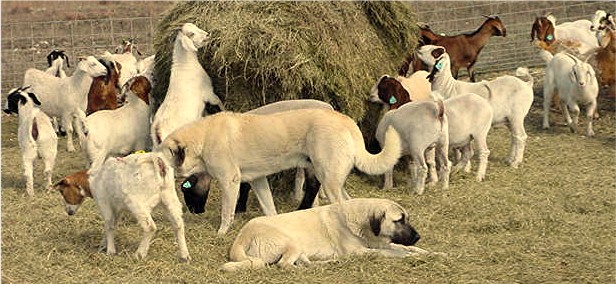 Lucky Hit Shadow Kasif (CASE) and Lucky Hit Shadow Seven living with goats |
||
|
An article originally appearing in the April, 1980, issue of "Amateur Farmer" was reprinted in the Anatolian Times (Vol. 1, 2008, pgs. 25-29), Livestock-Guardian Dogs, An Old World Solution to an Age-Old Problem, by Ray Coppinger and Lorna Coppinger. The following are my thoughts on some of the important and timeless ideas presented in this article. 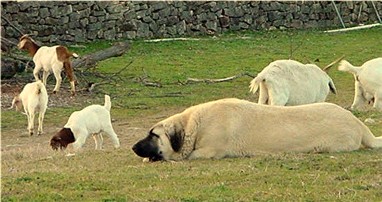 Lucky Hit Shadow Seven with her goats A question asked is "Could such dogs (livestock guardians) be adapted for use in the U.S., where, unlike Europe, all day shepherds are uncommon and predation is more intense?" The important thing to note is that IN EUROPE (and Turkey) ALL DAY SHEPHERDS ARE COMMON. That means that a pup has someone available to supervise his training all day. Yet here in the U.S. many livestock guardian owners just throw the pup out with their goats, sheep, chickens, ducks, horses, llamas, etc. and believe the pup will train itself. And to make matters even worse, some Anatolian breeders tell first time owners to put the pup with young stock unsupervised! To me, that idea is as ridiculous as believing that the perfect baby sitter for your two year old is another two year old! When someone is complaining that his/her pup isn't behaving like he/she wants, I hope he/she remembers that the 15 minutes a day he/she spends with the pup doesn't compare to the all day training the pup would have received in its country of origin! If someone wants better behavior from his/her pup, he/she needs to expend the time and energy required to insure the better behavior! Those not willing to expend the necessary time and energy should not purchase an Anatolian! 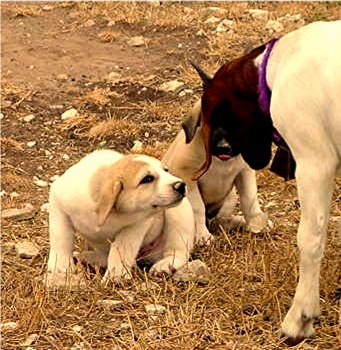 Lucky Hit Shadow Samson learns respect with older secure goats The article says "…the Turks say that you have to make the dogs vicious, and crop their ears so the flies keep them awake." I find that my Anatolians have the protective qualities fully ingrained genetically so I spend all my time teaching them to be accepting and compliant, NOT VICIOUS. I've found that no amount of socialization confuses them when someone is being aggressive toward me or their charges. No matter how friendly they have been to someone, if that someone changes and becomes aggressive toward me or toward their charges, my dogs have always intervened immediately and without confusion or direction from me! I work on socializing them and trust that their protective nature will take care of itself! 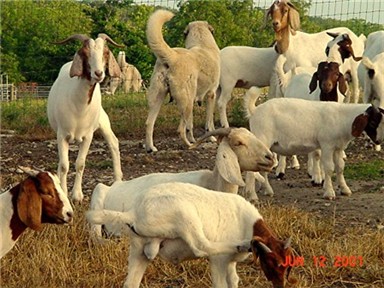 Lucky Hit Tawny Shadow with goats and on alert
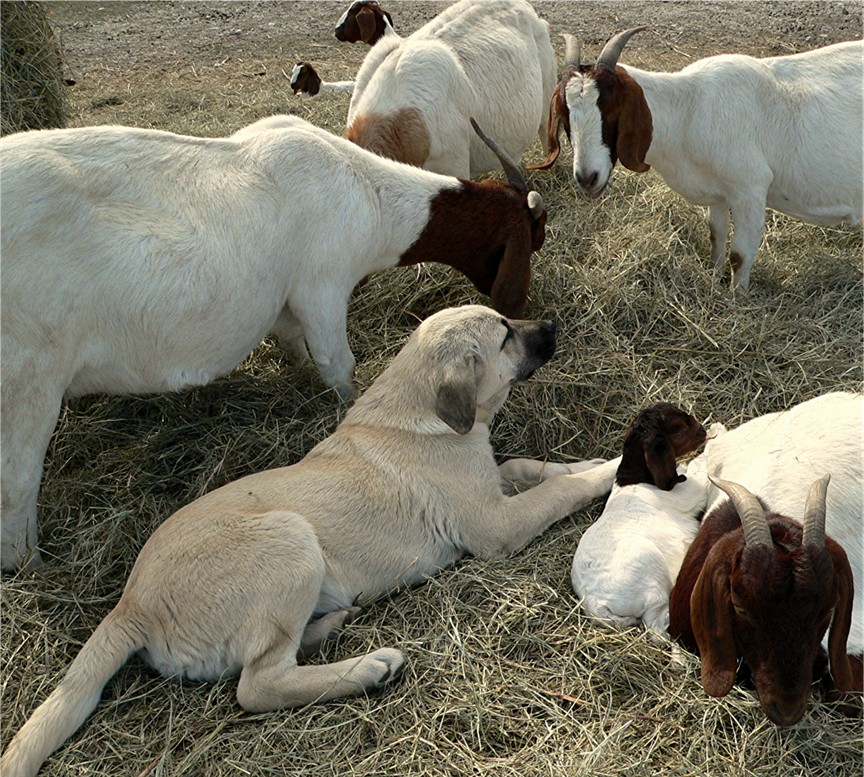 Lucky Hit Sahara Benek with goats and kids I agree that when purchasing an Anatolian pup, the pup should come from proven working stock to have a greater chance of obtaining a pup with good working genetics. I also agree that your chances of success are greater if your dog's immediate ancestors actively guarded livestock well, since the ability to guard can be lost just like other traits. That is why I encourage serious and diligent breeders to raise all potential breeding stock with sheep and/or goats (the animals of choice for proving working ability). Watching an Anatolian over time with sheep and/or goats in a predator rich environment is the only way I know of to truly test for working livestock ability. If Anatolian breeders ignore working ability in their selection process, it won't take many generations to develop Anatolians who cannot be trusted with livestock and who will not become reliable working guardians no matter how much training they receive. 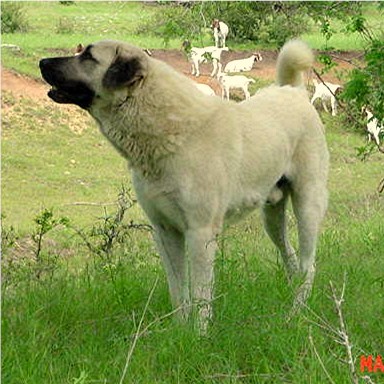 Lucky Hit Shadow Kasif (Case) guarding goats in the big pasture
A great paragraph in the article said "… Guarding dogs are placid, deliberate, and aloof; they work alone and without constant supervision. They respond slowly if at all to commands, and they do not control the flock, regardless of what you have heard. … They outweigh most of the popular herding breeds threefold, which contributes to their lack of enthusiasm for racing and chasing, but weighing about one hundred pounds is surely and advantage when confronting a mutt with mutton on his mind. In a fight, guarding dogs become lion quick and just as effective." 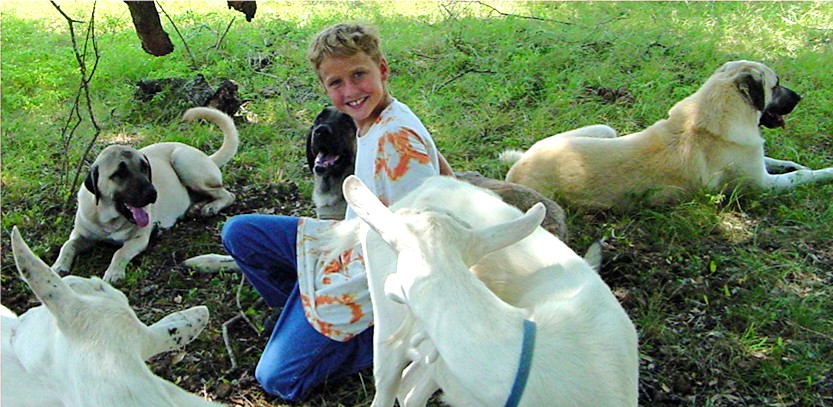 Lucky Hit Anatolians and goats in pasture with Joshua Since some breeders are advertising that their dogs weigh 150 pounds to as high as 200 pounds, it is important to note that in 1980 guardian breeds were considered to weigh about one hundred pounds… including Anatolians. I've noticed advertisements in old (late 1980's) Anatolian Times for really "huge" males with the male's weight listed at 120 pounds! I think it is important for serious breeders to keep this upward movement in Anatolian weight under control! Personally, I like males to weigh about 135 pounds and females to weigh about 115 pounds. My first male, Casy, was born in 1985 and weighed 115 pounds when fully adult! I thought he was huge at the time! I believe that when Anatolians become so huge they stand out from the goats and/or sheep (which weigh about 100 pounds) Anatolians have gotten too large. 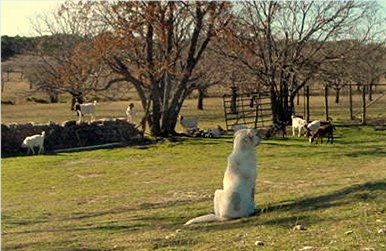 Lucky Hit Shadow Samson guarding goats at Lucky Hit Another concern I've had is that placid, deliberate, and aloof behaviors, all traits necessary in working Anatolians and other guardian breeds, are not being selected for in some show lines since many show judges don't like placid, deliberate, and aloof show dogs. Dedicated Anatolian breeder will breed for traits necessary in working guardians rather than selecting for traits a show judge desires that hinder Anatolian working behaviors. Of course, if a breeder doesn't maintain his/her Anatolians in a real world working setting, the breeder might have a very limited understanding of which traits help and which traits hinder working behaviors. 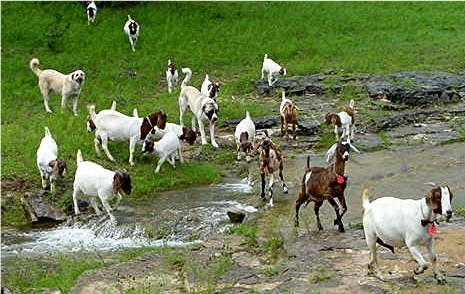 Lucky Hit Anatolians following the flock as the flock moves across the pasture The article states that "The most noteworthy aspect of a dog guarded sheep pasture is that nothing ever happens." For some reason, this lack of activity seems to bother some people. I receive calls from individuals who say that their dog does not work because the dog is always lying around and not always with its charges. My first question is "Have you had any animal losses?" They haven't. So I know that the dog is working and is smart enough to know when it has its area under control. Also, my dogs work all night, when the predators are most active, so during the day my dogs take some well deserved naps! 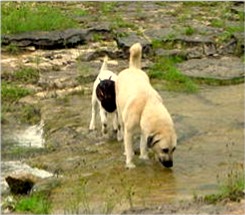 Lucky Hit Tawny Shadow with kid Another cue to proper Anatolian behavior is found when the article says "… At a distance, the dogs were inconspicuous, blending in with the sheep because of their behavior as well as their color. …" Sheep and goats are placid and deliberate when grazing and they do not socialize with each other in the engaging way selected for in many pet dogs. Aloof guardians mimic the less social behavior of their charges while more social guardians stand out from the herd, which is not desirable. 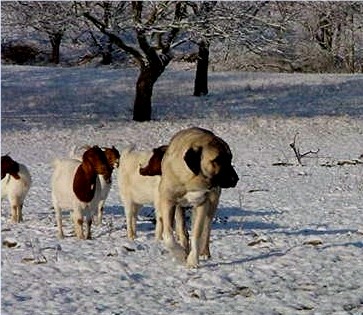 Lucky Hit Shadow Sahara moving across the pasture with goats Another important difference between guardian dogs and regular dogs was highlighted by the following: "What impressed us most about these … (guardian dogs) … was a behavior pattern common to them; but rare in nonguarding breeds. This behavior expressed what we referred to as the 'following' instinct. It's this apparent preference for the company of sheep over anything else that shapes the whole behavioral repertoire of a livestock guarding dog. Not only do the dogs act as if they themselves were members of the flock, but they stay right with it wherever it goes. The dogs meander along, heads and tails lowered, looking for all the world like sheep. Often they walk right in among the flock, and when the heat of the day sends the sheep to munch in the shade, the dogs lie right in with them." More information about the following instinct can be found in my article entitled, "Staying with Goats Throughout the Day" or "The Following Instinct," written by Erick Conard, Lucky Hit Ranch. Please note that the article says "The dogs meander along, heads and tails lowered, looking for all the world like sheep." Tails lowered! It is important to remember that the tail position of a guardian means something significant. The lowered tail position means the flock is grazing and all is well... no stress or concern on the part of the guardian. The moment that changes the tail goes up! I have heard some individuals who show Anatolians incorrectly explaining to people that the tail must be up and curled. There is a time for that position, but not always! When an Anatolian is off territory and wants to signal that it is not intending to cause trouble, it will lower its head and keep its tail lowered. While it might look pretty to see the head and tail up at a show, one must remember an Anatolian is signaling his emotional state with his tail and it is appropriate for the Anatolian to signal it is off-territory and not feeling aggressive. When the Anatolian moves across territory he generally holds his tail up. At a show a dog holding his tail up might be signaling movement across territory. When my dogs are after a predator, they hold their tails straight up and waving back and forth vigorously. 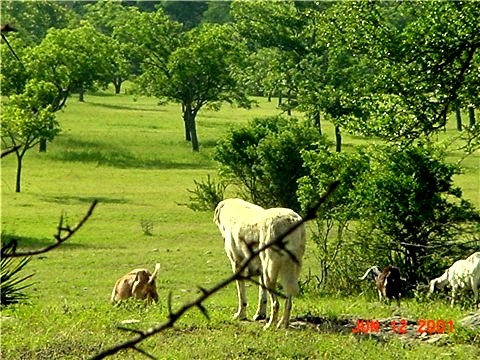 Lucky Hit Tawny Shadow with tail down (all is well) position I was particularly intrigued to note that that in 1980 the "following" instinct (the instinct to follow the herd as it grazes across larger pasture land) is assumed to be an integral aspect of guardian breeds that "shapes the whole behavioral repertoire of a livestock guardian dog." Especially since I remember how strong this behavior was in all of my original Anatolians in the 1980's; dogs with close genetic ties to Turkish livestock guardians. 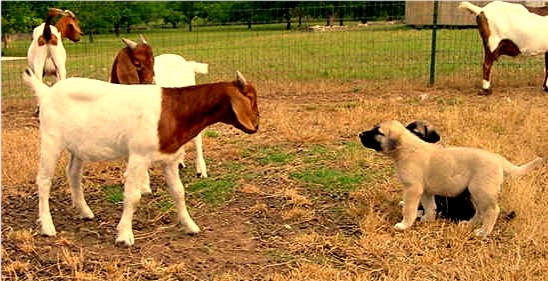 Lucky Hit Shadow Kasif (Case) and Lucky Hit Shadow Sahara with goats I believe that the "following" instinct is being lost over time in our American Anatolians. I have been receiving calls (with increasing frequency) from Anatolian owners who complain that their Anatolian pup, who was raised with livestock, does not seem well bonded to their livestock and does not follow the herd ever. I have 50 acres and my dogs have been able to keep it predator free without being with the livestock all the time. However, I have noticed that some dogs I own tend to hang with the livestock no matter what whereas others are with the livestock much less often. Since my primary concern is working ability, my breeding preference is for the dogs who love hanging out with the livestock. I have always wondered how Anatolian breeders without livestock can select for this vital guardian trait! I believe the "following" instinct is a behavioral trait that is decreasing in its prevalence in the breed and serious breeders need to begin paying attention to this important guardian trait in their selection process or it will eventually be lost to the breed. Here is a link to my article, "The Following Instinct", Staying with Goats Throughout the Day. 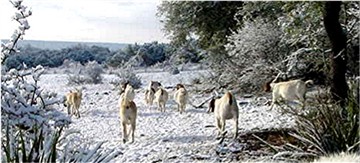 Lucky Hit Anatolians following the flock as the flock moves across the pasture The articles continues "… Good guarding dogs don't chase after the intruder, but remain close to their flock. We began to draw a profile of a good livestock guarding dog: (1) he must not chase or kill sheep; (2) he must follow the sheep around, unsupervised, twenty-four hours a day; and (3) he must protect the flock from predators." 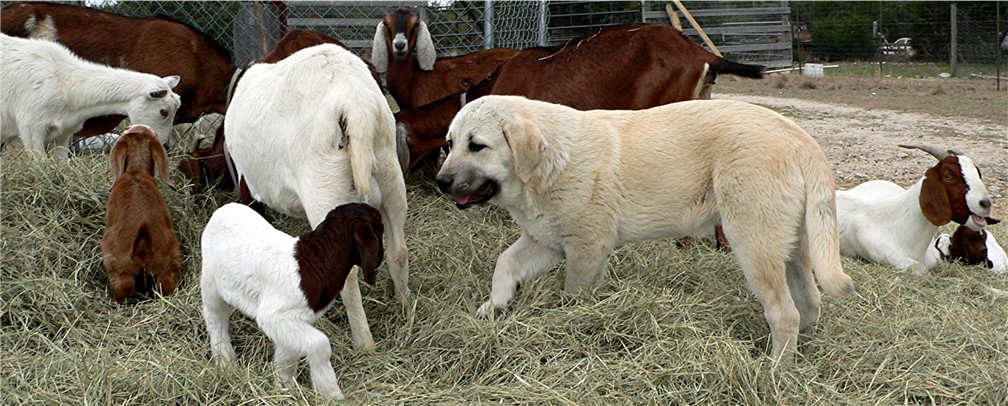 Champion Lucky Hit Shadow Zirva with goats and kids as a pup February 17, 2008 Zirva took Group 2 and became AKC's #1 All Breed Anatolian Zirva lives full time in the pasture guarding goats, ducks, geese, and llamas These three guardian behaviors are essential in Anatolians. How can breeders select for these essential behaviors if they do not maintain their Anatolians with sheep and/or goats in a predator rich environment? Some breeders fully understand that good conformation and genetic health must be selected for each generation with great care and discrimination. And yet many of these breeders do not place their Anatolians in a guardian environment, an environment necessary to select behavioral traits essential in Anatolians; to understand an Anatolian's behavioral traits with any degree of accuracy, the Anatolian must be raised with sheep and/or goats in a predator rich environment. Anatolians without good guardian behaviors cannot be trusted with livestock. 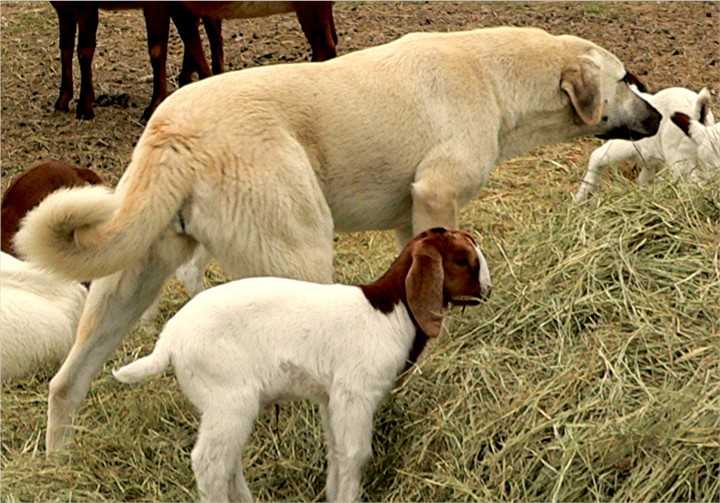 Lucky Hit Akasma Vasi with goat kids A statement I found of interest was "… the breed clubs are eager to ensure that their traditional guarding dogs are propagated with their guarding abilities intact." I hear a lot of lip service from many Anatolian breeders and club leaders that maintaining guardian ability is vital in breeding selection. However, only those individuals willing to do the great deal of work it takes to raise their Anatolians with sheep and/or goats (not horses, cattle, etc.) are taking the steps required to understand the true flock guarding nature of the dogs they select for breeding. If I wanted to breed Anatolians but hadn't raised my females in a real world working environment (with sheep and/or goats surrounded by serious predators), I would, as a minimum, chose a proven and superior working Anatolian male to breed to my unproven female. While some well known breeders follow this philosophy, I've noticed that many do not and breed females with unknown working ability to males with unknown working ability! I do not understand this philosophy. To me it's like selecting dogs to be bred for conformation sight unseen and conformation unknown. Everyone seems to know that doesn't work! 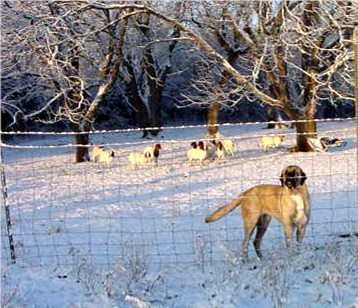 Lucky Hit Shadow Sahara guarding goats in the big pasture In addition, I've been told that some breeders claim that their dogs are raised and kept with sheep and/or goats but the Anatolians are not kept in the same pastures as the flock animals. This method of housing might give some small amount of information but the behavioral information about the Anatolian is limited without continuous observation and exposure over time. Other breeders claim their dogs are guarding horses or cattle, and their dogs may or may not be in the pasture with the horses and/or cattle. How the Anatolian deals with the larger animals does provide useful information but does not provide useful insight regarding how the Anatolian will handle a 3 or 4 pound newborn or how it will interact with flock animals its own size and weight. Therefore, I think it is wise to critically question any prospective breeder regarding exactly how they have ascertained the behavioral characteristics of their "working" Anatolians. 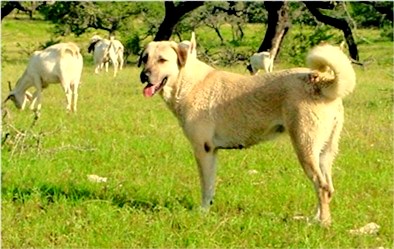 Lucky Hit Tawny Autumn guarding goats in the big pasture The following paragraph from the article is one of the most important working tips in the entire article. " … Most guarding dogs don't work very well in the field during their first year, no matter what you do. They'll chase sheep or play with them so hard that they sometimes hurt or even kill them. What can a farmer do? In training, the young dog should tag along with you during chore time, learning your routine, your attitude toward your animals, and your farm's boundaries. Praise and pat him, discipline him for transgressions, but never leave him alone with the sheep before his mature guarding behavior develops." In my experience, this statement isn't quite accurate. I'm wondering if the dogs he is talking about weren't placed with the proper level of training sheep and/or goats! With excellent training goats, I've had great success with all the pups I've raised. As a last resort, you can temporarily remove a pup that is having difficulty expressing the proper level of respect toward its training goats and follow the above advice. But any pup that was that difficult to train I would NOT consider as a breeding prospect!!! To me, they would lack a sufficient level of correct working genetics to be used as a breeding Anatolian! (Naturally, a breeder has to have their Anatolians, including the pups, living 24/7 with sheep and/or goats to have any idea regarding the actual level of working ability in their Anatolians!) 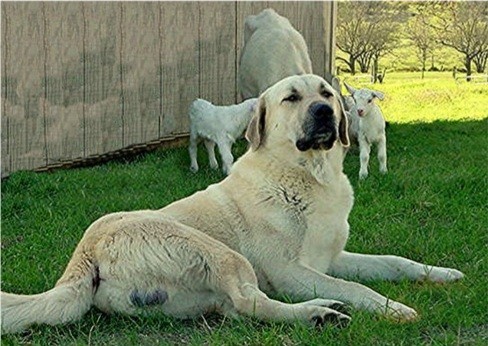 Champion Birinci's Yahsi guarding kids This article was written in 1980 and cautions owners to never leave a young pup alone with sheep before the pup's mature guarding behavior develops. I can't understand why some breeders still tell people to put their young Anatolian with lambs or kids and just let them grow up together, unsupervised (a sure method for disaster). This advice sounds great, since it takes so little work, and people love being told to do something that takes no time or effort. However, if you are working with your pup properly you will be spending a great deal of time for the first year or two guiding and directing your pup's behaviors with their livestock on a daily basis. If you are not dedicated to working with your young guardian every day, doing whatever it takes to ensure proper behavior, you are probably not a good candidate to own an Anatolian.  Champion Inanna Bethany Bay of Lucky Hit learns about goats as a pup The article says "To push a dog before he is ready is asking for trouble. If a pup does kill a sheep, though, it's not the end of the world. The widespread belief that a dog that's tasted blood will kill again and again is not widely held by Old World shepherds, who supplement their guarding dog's daily porridge with the carcasses of dead sheep. We don't recommend doing this, mainly because of disease transmission." I agree that if a pup kills an animal, it does not mean the pup is ruined. I immediately place the blame firmly where it belongs… ON ME! I was responsible for providing an environment that taught the pup correct guardian behaviors. Therefore, the pup's failure is ultimately my failure. I failed to provide the proper environment because I placed an animal with the pup that was not capable of demanding and receiving respect. If I'd only had animals with the proper "strength" with the pup, then the pup would not have killed. Instead, the pup would have been punished by the animal for daring to disrespect that animal with rough play. And if none of my animals can demand and receive respect I remove the dog from the animals except when I'm there to demand respect for the dog's charges. I've also found that eating goat meat does not cause Anatolians to attack and kill goats, at least is hasn't in my dogs. 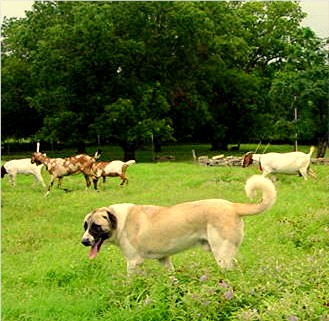 Lucky Hit Shadow Beau as a youngster The article quotes a rancher in Alberta who had lost several sheep to the guardian pup that had been supposedly raised with sheep. The rancher is quoted as saying "As I see it now the most important point is that the pup be raised with orphan lambs from three weeks of age. At four or five months these dogs are too big, puppyish, and as yet undisciplined to be with sheep for the first time." Reading this, I was not surprised this rancher had lost several sheep to his guardian pup. Leaving an immature guardian pup with young stock does not teach the pup to respect animals in the flock. Only older crotchety bossy and protective sheep and/or goats should be left with young dogs unsupervised. And the MINUTE you see the pup getting away with being disrespectful to any animal in its charge, that animal must be removed! Only animals that demand and receive respect from the pup can be left with the pup during the training phase (which may last two years). And if none can get that respect, it is up to the owner to provide the necessary corrections each and every time the pup misbehaves in any way. Of course, animals that are mean and abusive to the pup must be removed as well or the pup will not develop the loving bond necessary to hold the pup closely to the flock. 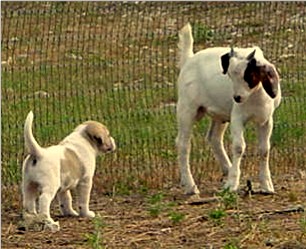 Lucky Hit Shadow Samson as a youngster with goats The next paragraph supports my philosophy that a young dog must never be left alone with livestock weaker than the dog and incapable of demanding and receiving respect from the dog. "As your guarding dog grows, he'll demand an extra measure of your understanding of animal behavior. Growing pups love to run and chase, especially if gamboling lambs are about. They're trying to play, not prey. But a lamb is no match for a twenty-five pound puppy, and injury or worse can occur. What to do? Scold him, severely, when it happens. More important, don't leave him unsupervised with lambs until he is mature enough and has proven himself trustworthy. Making this judgment takes cautious and repeated trials when he is a year or more old. If you have a grouchy ewe, she can sometimes administer lessons in good manners to an out-of-line dog. With lambs, especially, you have to be careful. Some dogs may never learn to leave them alone." 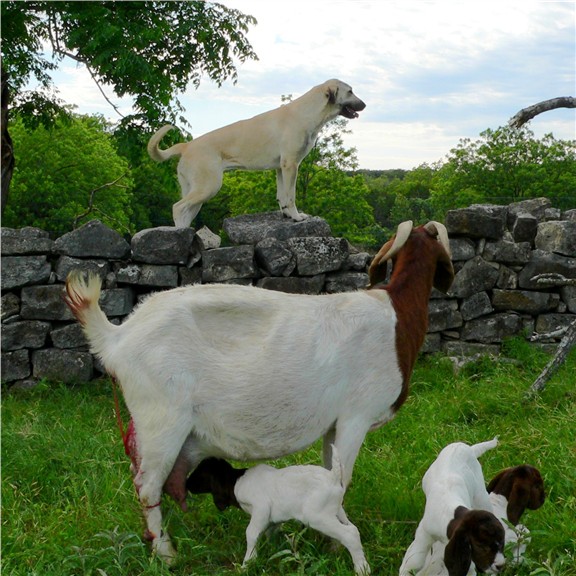 Champion Inanna Bethany Bay of Lucky Hit guarding newborns The sentence you want to remember above all others is "More important, don't leave him unsupervised with lambs until he is mature enough and has proven himself trustworthy." So many people want to rush their dog's maturity and leave their young pup, unsupervised, with young stock. In this case the owner is at fault when the pup learns to disrespect his charges and plays too rough, even killing his charges. I repeat, the owner, who is supposed to have the bigger brain, is at fault. However, the dog is the one that pays the ultimate price for the owner's lack of diligence when the owner puts the unruly pup down! Another great thought in the article follows: "An additional benefit in giving a young dog close supervision during the first year is that you will foster a close attachment between you and him. You should make good friends with him, and include your family in this, for you are the pivots around which his responsibilities revolve. Sheep come and go, and pastures change, but the farmer remains constant. …." 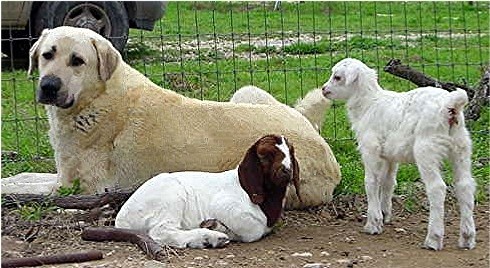 Champion Birinci's Yahsi guarding newborns at Lucky Hit I believe that one of the most important keys to a good guardian relationship is the interaction between my dogs and me. I try to establish a very close and loving relationship with each and every dog I raise and in return, I find that my dogs try diligently to please me in every way they can, making the training process much easier than it would have been otherwise. It is possible to have my dogs love me and still want to stay with their charges. I work on this when they are pups on a daily basis and it is ongoing through their second year. The pups have to be behind a fence they can't possibly make it through. That way, as I come and go the pups learn to turn to their charges for comfort after I leave rather than expending energy trying to get through the fence to follow me to the house. 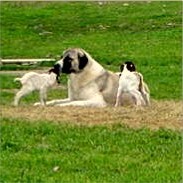 Lucky Hit Shadow Beau guarding newborns The article points out "By the time a good dog is almost a year old, he has adopted the sheep as his constant companions; he follows them everywhere. The barn, the people who have befriended and disciplined him, even a yard dog he may have played with, are becoming secondary to him. He shows increasing seriousness about his role as guardian, and possesses the guarding dog's first line of defense: high-pitched, crisis barking, accompanied by a rush toward the encroaching object, with bushy tail held high." The better working Anatolians make this transition to greater commitment to their sheep and/or goats than to anything else in their lives. However, some Anatolians don't make the transition and so do not have the same excellent level of working ability as those dogs who do. Of course, if you haven't raised your Anatolians with goats and/or sheep you won't have any way to know whether or not they lack this working trait when making your breeding decisions. 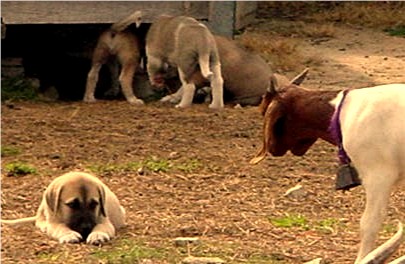 Lucky Hit pups being raised with goats at Lucky Hit Ranch Note the excellent submissive posture In addition, the environment in which you have raised the pup has a major influence on how well the pup transitions to a committed working dog. If you have placed the pup with mean and aggressive charges, don't be surprised if the pup is less eager to commit to friendly interaction with its charges. Likewise, if you placed the pup with weak charges who don't demand and receive respect, don't be surprised if the pup has bonded to its charges but plays with intolerabe aggression with them. I always remember that I created the environment in which my pup was raised. Therefore, I know I created the behavioral outcome I see in the pup! There is a window of opportunity open to affect the pup's basic behaviors. I know I must work with the pup's behavior before that window closes (at about two years). After that I have to deal with the dog behaviors as they were molded. 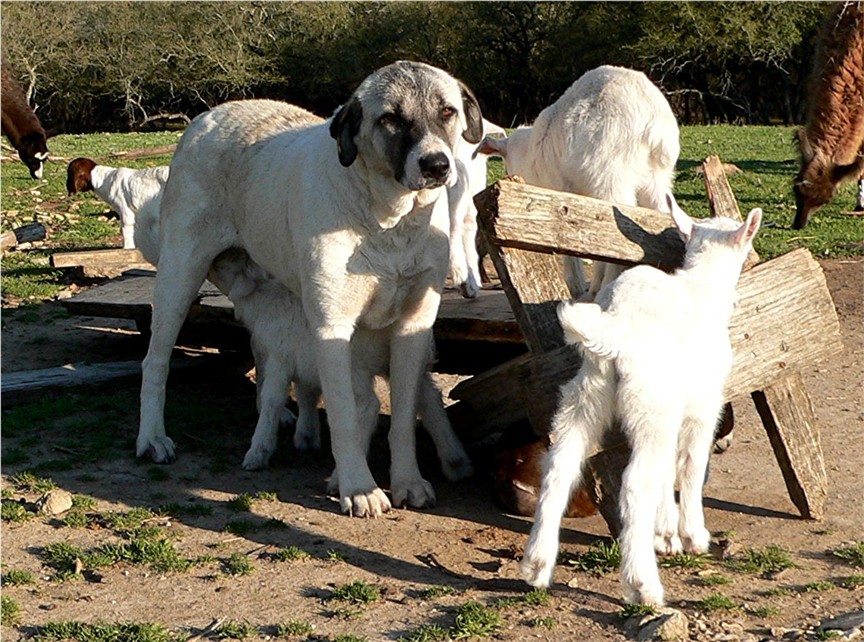 Cerulean Lexa Guzel of Lucky Hit guarding young kids and llamas at Lucky Hit Ranch The article again highlights the importance of the "following" instinct. "Even a year-old dog is still a youngster, and hasn't yet the size and strength to be one hundred percent effective against a large, mature predator. But, if he has a good following instinct, he will at least try to do what's expected." An example of the proper interaction for a young guardian dog follows. "In Missouri, a young Maremma set up a tremendous ruckus when a German Shepherd jumped the fence and began chasing the lambs. The flock bunched together and retreated, but one lamb ran the wrong way and the invader went after it. The Maremma, hackles raised but tail submissively down, barking his characteristic 'trouble!' warning, stayed between the dog and the flock. The farmer was brought to the scene by the Maremma's alarm and rescued the lamb, but he was disappointed that his guarding dog let him down by not attacking the Shepherd and driving it off. However, this inexperienced eight month old Maremma was governed by a confusing set of signals. For him to attack a mature, heavier dog would have been foolish, and probably would have resulted in greater damage to the flock. He did the right thing and achieved the desired result." 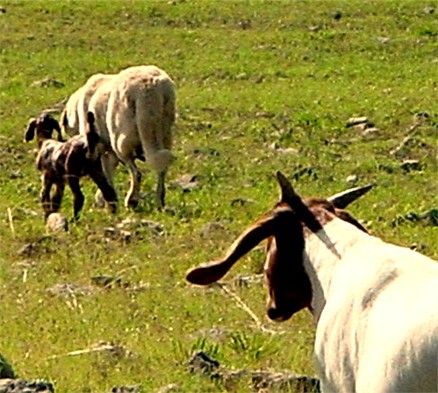 Lucky Hit Tawny Shadow following herd with young kid at side While I know my young Anatolians have done some amazing things, I do not expect them to consistently show mature adult guardian responses until they are at least two years old. I understand that they must assess the predator and that younger, inexperienced dogs will not defend their charges with the same level of aggression that I see in mature guardians. A young Anatolian that shows strong aggression will be VERY aggressive as an adult and may require special handling. An example (among many) of a young Lucky Hit Anatolian showing early signs of adult working behavior was seen in Lucky Hit Shadow Duvar, who arrived at his new home, a boer goat ranch in Kentucky, when he was about four months old. He'd been there only about thirty days when a stray dog attempted to get into the pasture where he and his goats lived. Even though he wasn't quite five months old, Duvar skillfully manuevered his goats into the far corner of the pasture and stood protectively between his goats and the stray dog, keeping the dog at bay. According to his new owner, Duvar is a wonderful, no-nonsense working dog who enjoys spending time with his charges. It appears Duvar has the "following" instinct because he spends his time in the pasture with his goats rather than laying around the barn without them. Duvar's new owner reports that Duvar has the desirable aloof personality and is respectful to the family, including their young daughter. 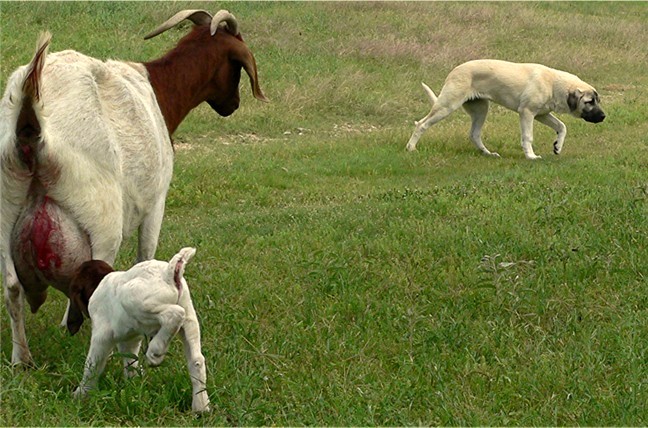 Champion Ashley Manor DivaKiz Lucky Hit (Kizzie) when a pup respectfully keeping her distance from newborns at Lucky Hit Ranch Kizzie was the #2 AKC Breed Female in 2007 and guards goats, llamas, ducks, geese full time on the ranch The article provides information about early mature behavior. "By the time he reaches two years, your dog will know exactly how to handle intruders. The routine of the sheep pasture is sacred. Any untoward interruption is met by the barking that cautions that the dog is disturbed. This warning is usually enough to convince the wary, but if it isn't, the guarding dog is likely to solve the problem. This is usually the way you want it, but not always. In Iowa, with the farmer away, a Maremma put an unwelcome stranger out of the barn with his leg nipped, but it could have been a family friend." Keep in mind that, although there is a genetic component in how your dog behaves, your training, or lack of it, also has its affect on how your dog handles intruders. Do the training while the window of opportunity is open... it is slowly closing and will mostly be shut after two. All of my training is focused on getting the dog to trust me and follow my directions (since Anatolians naturally tend to make decisions on their own). I also work to teach my dogs that if I am happy with someone my dogs need to be happy with them as well. Of course, if a stranger behaves improperly, being Anatolians, my dogs will respond no matter how much training I've done. 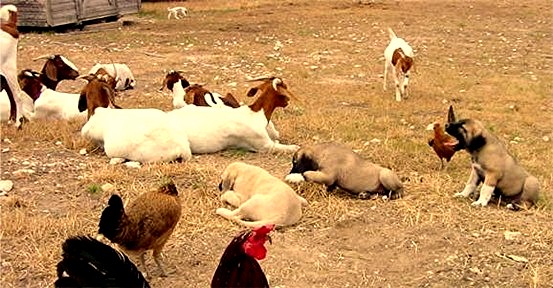 Lucky Hit pups being raised with livestock Like the article says, routine is sacred to an Anatolian. Anything out of the ordinary is likely to generate a reaction. The article continues "A guarding dog is going to guard, and you have to take that into account. You can't tell your sheep shearer that you won't be home when he gets there but go ahead into the barn and begin. … The dogs are not 'trigger-happy,' but they do attempt to repel what they see as threats." "... they do attempt to repel what they see as threats." I know that if I'm perceived to be the threat, they will attempt to repel me as well. So I try to never appear to be the threat. I always maintain an alpha position and provide guidance and direction... but I don't ever become the threat. Anatolians have been selected for hundreds of years to stand firm when confronted by serious predators like wolf packs, bears, and lions. I don't ever let their being respectful to me fool me into believing that if I become the threat I could physically dominante them. I can't. I will always lose in a physical contest with an Anatolian. So I don't ever have one! 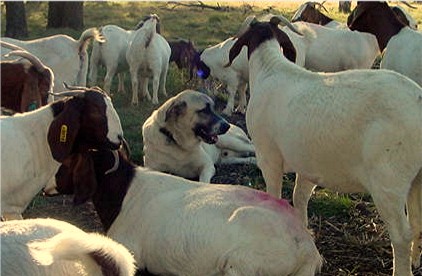 Lucky Hit Shadow Major guarding registered boer goats One of the most important thoughts in the article follows. "Benefits to a sheep farmer with a mature guarding dog can far outweigh any problems. As long as you remember that the dogs are not robots, no matter how well trained, and that even the good ones can make mistakes, you'll be well on your way to working satisfactorily with your dog." Although the Anatolian has amazing guardian genetics and exceptional intelligence, an Anatolian still depends on his owner to create an environment that automatically corrects for improper behaviors. The most successful owners of working livestock guardians know that when their dogs behave improperly, the correct response is to place the responsibility for the dog's failure on themselves rather than on the dog. Then they can take steps to alter the dog's environment so it will automatically correct the dog's behavior whether or not the owner is present. 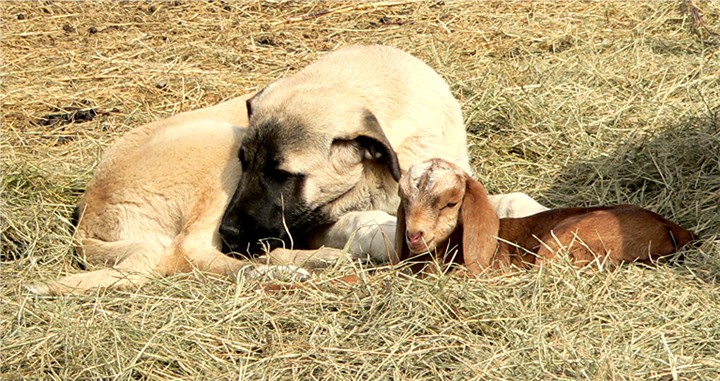 Lucky Hit Sahara Kizil with kid |
Link to Lucky Hit Ranch Main Home Page
Link to Lucky Hit Ranch Anatolian Page